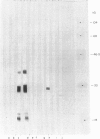Abstract
Among the potentially vaccinating antigens, the products excreted/secreted by the parasite T. gondii have been demonstrated to be excellent candidates. The molecular cloning of one of these antigens (P24) present in excreted/secreted antigens (ESA) has recently been carried out in our laboratory. The recombinant antigen P24 corresponds to a native molecule of 23 kD. We were interested in determining the main epitopes of the P24 antigen eliciting a T lymphocyte response using synthetic peptides derived from the primary structure of P24. Five peptides: 64-79, 88-109, 170-193, 194-208 and 231-250 were synthesized according to their hydrophobicity, mobility and accessibility profiles. The presence of T lymphocyte epitopes in these peptides has been examined in the rat model. The determination of T cell epitopes was carried out using T lymphocytes from infected rats, and from ESA and P24 expression vaccine virus immunized rats. The results showed that the stimulation of T cells with these peptides varied according to the period after Toxoplasma infection. The main T cell stimulation was obtained with the 88-109, 170-193 and 194-208 peptides. When Fisher rats were immunized with ESA, a most significant stimulation was achieved with the 170-193 and 194-208 peptides. In addition, T lymphocytes primed with P24 expressed vaccine virus immunization were more stimulated with the 88-109 and the 194-208 peptides. This study showed that P24-derived peptide-specific T cells were elicited in the three experimental situations, although no antibody response against the 23-kD native antigen was evidenced in the Fisher rat model. However, the native antigen (presented by irradiated parasites) can induce a proliferative response of the 170-193 peptide-specific T lymphocytes, confirming that this peptide contains an important T cell epitope. The adoptive transfer into athymic rats of T helper cells recovered from 170-193 peptide-immunized Fisher rat conferred a significant protection to infected nude rats despite the fact that no antibody production was observed.
Full text
PDF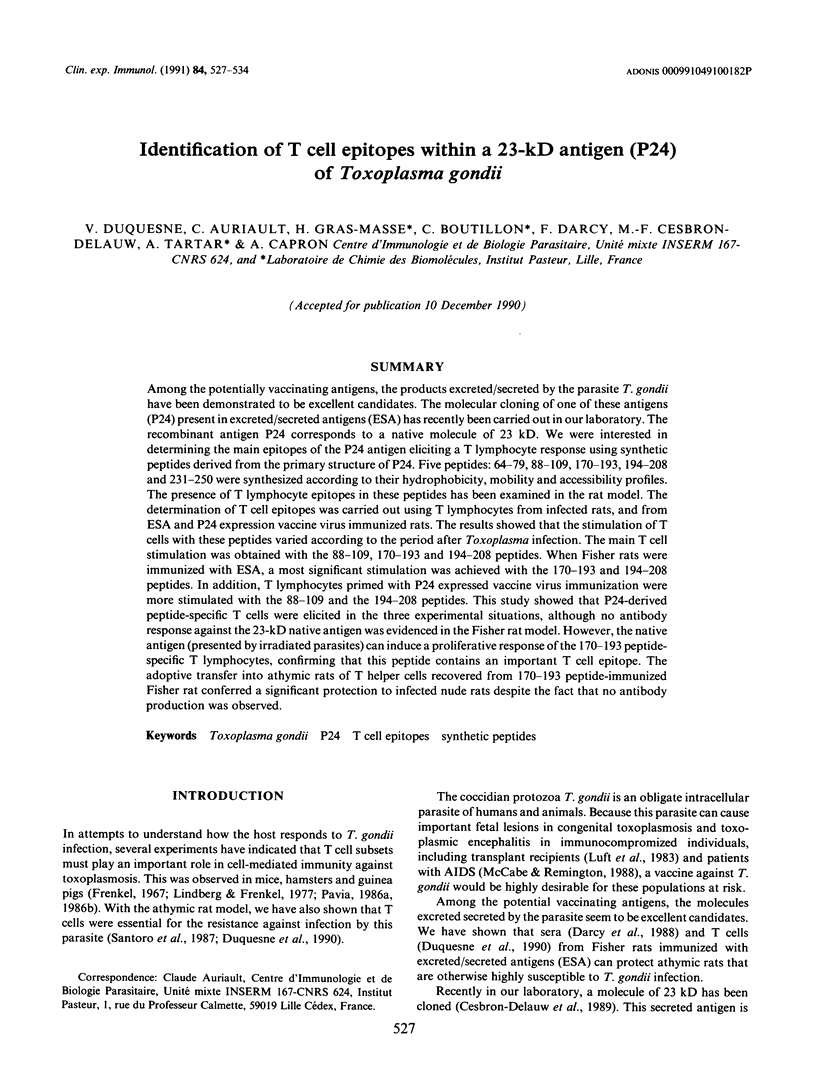
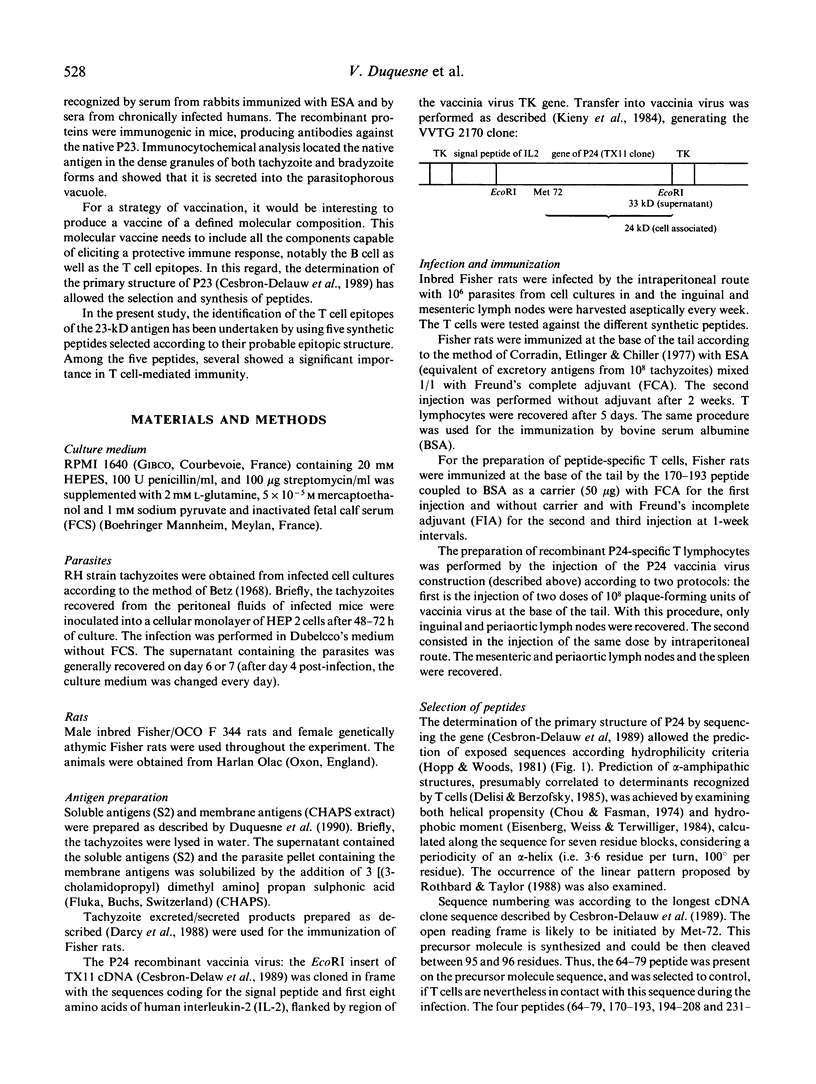

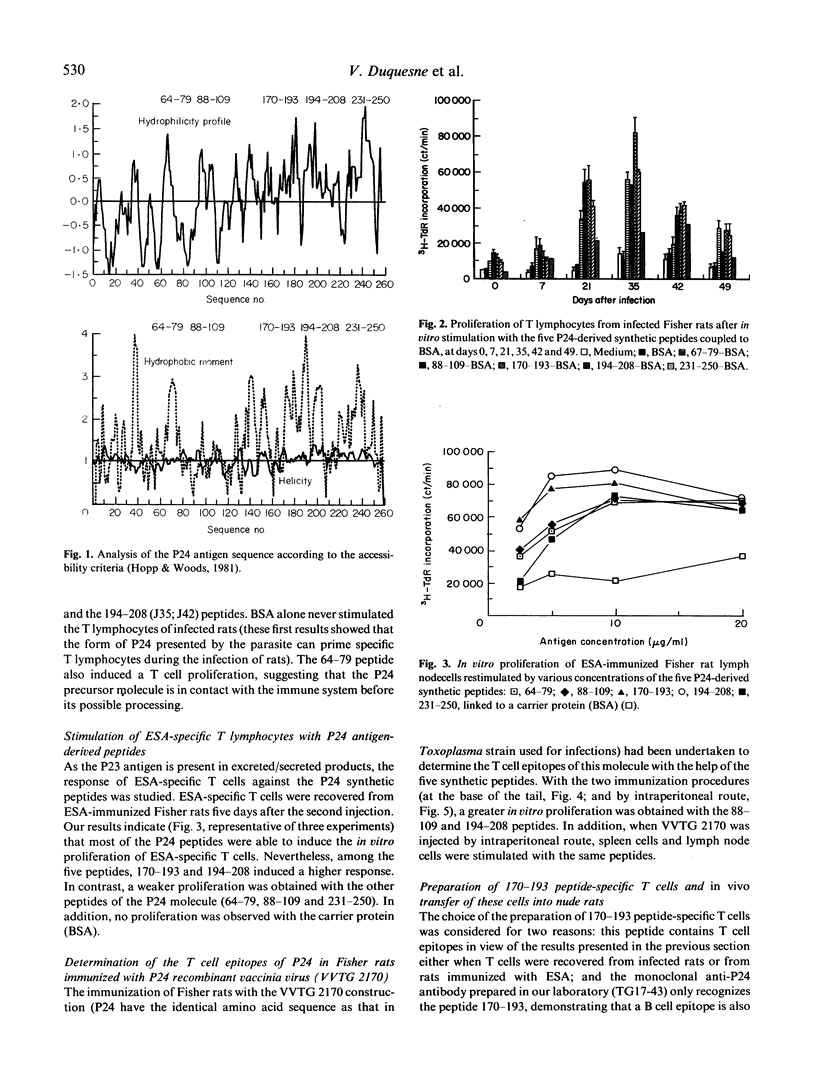


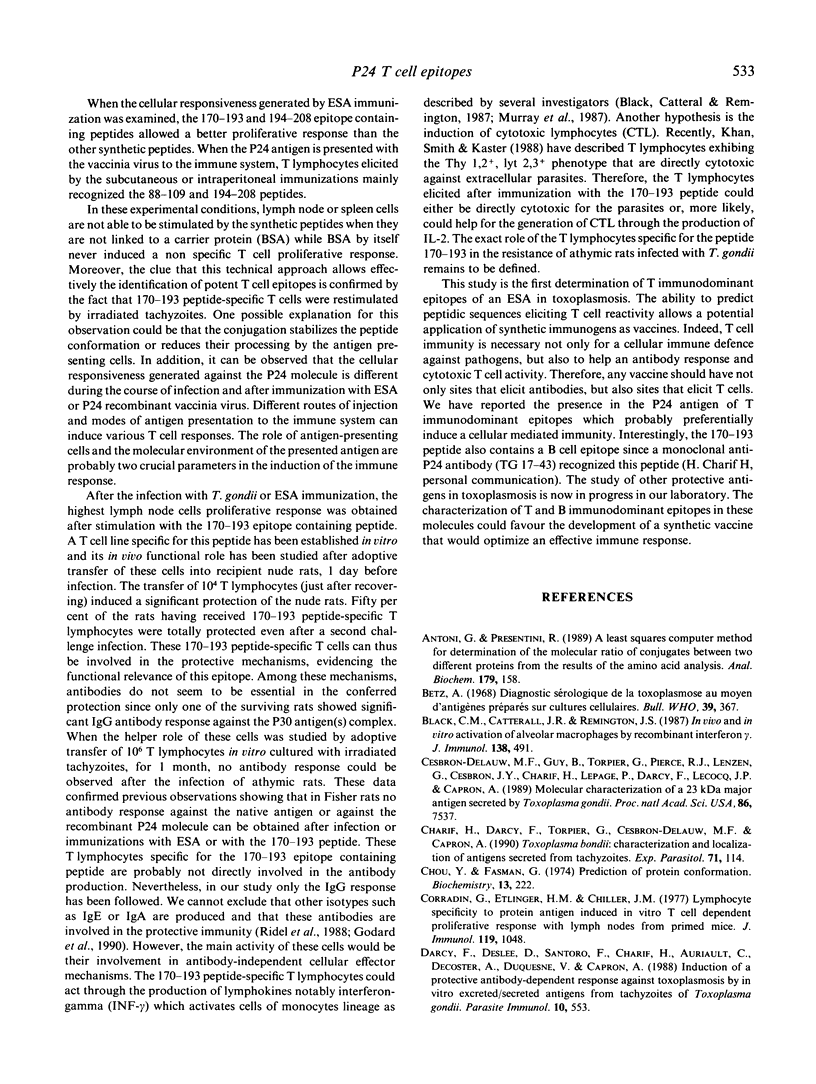

Images in this article
Selected References
These references are in PubMed. This may not be the complete list of references from this article.
- Antoni G., Presentini R. A least-squares computer method for the determination of the molecular ratio of conjugates between two different proteins from the results of the amino acid analysis. Anal Biochem. 1989 May 15;179(1):158–161. doi: 10.1016/0003-2697(89)90217-0. [DOI] [PubMed] [Google Scholar]
- Betz A. Diagnostic sérologique de la toxoplasmose au moyen d'antigènes préparés sur cultures cellulaires. Bull World Health Organ. 1968;39(3):367–374. [PMC free article] [PubMed] [Google Scholar]
- Black C. M., Catterall J. R., Remington J. S. In vivo and in vitro activation of alveolar macrophages by recombinant interferon-gamma. J Immunol. 1987 Jan 15;138(2):491–495. [PubMed] [Google Scholar]
- Cesbron-Delauw M. F., Guy B., Torpier G., Pierce R. J., Lenzen G., Cesbron J. Y., Charif H., Lepage P., Darcy F., Lecocq J. P. Molecular characterization of a 23-kilodalton major antigen secreted by Toxoplasma gondii. Proc Natl Acad Sci U S A. 1989 Oct;86(19):7537–7541. doi: 10.1073/pnas.86.19.7537. [DOI] [PMC free article] [PubMed] [Google Scholar]
- Charif H., Darcy F., Torpier G., Cesbron-Delauw M. F., Capron A. Toxoplasma gondii: characterization and localization of antigens secreted from tachyzoites. Exp Parasitol. 1990 Jul;71(1):114–124. doi: 10.1016/0014-4894(90)90014-4. [DOI] [PubMed] [Google Scholar]
- Chou P. Y., Fasman G. D. Prediction of protein conformation. Biochemistry. 1974 Jan 15;13(2):222–245. doi: 10.1021/bi00699a002. [DOI] [PubMed] [Google Scholar]
- Corradin G., Etlinger H. M., Chiller J. M. Lymphocyte specificity to protein antigens. I. Characterization of the antigen-induced in vitro T cell-dependent proliferative response with lymph node cells from primed mice. J Immunol. 1977 Sep;119(3):1048–1053. [PubMed] [Google Scholar]
- Darcy F., Deslee D., Santoro F., Charif H., Auriault C., Decoster A., Duquesne V., Capron A. Induction of a protective antibody-dependent response against toxoplasmosis by in vitro excreted/secreted antigens from tachyzoites of Toxoplasma gondii. Parasite Immunol. 1988 Sep;10(5):553–567. doi: 10.1111/j.1365-3024.1988.tb00242.x. [DOI] [PubMed] [Google Scholar]
- DeLisi C., Berzofsky J. A. T-cell antigenic sites tend to be amphipathic structures. Proc Natl Acad Sci U S A. 1985 Oct;82(20):7048–7052. doi: 10.1073/pnas.82.20.7048. [DOI] [PMC free article] [PubMed] [Google Scholar]
- Duquesne V., Auriault C., Darcy F., Decavel J. P., Capron A. Protection of nude rats against Toxoplasma infection by excreted-secreted antigen-specific helper T cells. Infect Immun. 1990 Jul;58(7):2120–2126. doi: 10.1128/iai.58.7.2120-2126.1990. [DOI] [PMC free article] [PubMed] [Google Scholar]
- Eisenberg D., Weiss R. M., Terwilliger T. C. The hydrophobic moment detects periodicity in protein hydrophobicity. Proc Natl Acad Sci U S A. 1984 Jan;81(1):140–144. doi: 10.1073/pnas.81.1.140. [DOI] [PMC free article] [PubMed] [Google Scholar]
- Frenkel J. K. Adoptive immunity to intracellular infection. J Immunol. 1967 Jun;98(6):1309–1319. [PubMed] [Google Scholar]
- Godard I., Darcy F., Deslee D., Dessaint J. P., Capron A. Isotypic profiles of antibody responses to Toxoplasma gondii infection in rats and mice: kinetic study and characterization of target antigens of immunoglobulin A antibodies. Infect Immun. 1990 Aug;58(8):2446–2451. doi: 10.1128/iai.58.8.2446-2451.1990. [DOI] [PMC free article] [PubMed] [Google Scholar]
- Hopp T. P., Woods K. R. Prediction of protein antigenic determinants from amino acid sequences. Proc Natl Acad Sci U S A. 1981 Jun;78(6):3824–3828. doi: 10.1073/pnas.78.6.3824. [DOI] [PMC free article] [PubMed] [Google Scholar]
- Julius M. H., Simpson E., Herzenberg L. A. A rapid method for the isolation of functional thymus-derived murine lymphocytes. Eur J Immunol. 1973 Oct;3(10):645–649. doi: 10.1002/eji.1830031011. [DOI] [PubMed] [Google Scholar]
- Khan I. A., Smith K. A., Kasper L. H. Induction of antigen-specific parasiticidal cytotoxic T cell splenocytes by a major membrane protein (P30) of Toxoplasma gondii. J Immunol. 1988 Nov 15;141(10):3600–3605. [PubMed] [Google Scholar]
- Kieny M. P., Lathe R., Drillien R., Spehner D., Skory S., Schmitt D., Wiktor T., Koprowski H., Lecocq J. P. Expression of rabies virus glycoprotein from a recombinant vaccinia virus. Nature. 1984 Nov 8;312(5990):163–166. doi: 10.1038/312163a0. [DOI] [PubMed] [Google Scholar]
- Laemmli U. K. Cleavage of structural proteins during the assembly of the head of bacteriophage T4. Nature. 1970 Aug 15;227(5259):680–685. doi: 10.1038/227680a0. [DOI] [PubMed] [Google Scholar]
- Lindberg R. E., Frenkel J. K. Toxoplasmosis in nude mice. J Parasitol. 1977 Apr;63(2):219–221. [PubMed] [Google Scholar]
- Luft B. J., Naot Y., Araujo F. G., Stinson E. B., Remington J. S. Primary and reactivated toxoplasma infection in patients with cardiac transplants. Clinical spectrum and problems in diagnosis in a defined population. Ann Intern Med. 1983 Jul;99(1):27–31. doi: 10.7326/0003-4819-99-1-27. [DOI] [PubMed] [Google Scholar]
- Murray H. W., Scavuzzo D., Jacobs J. L., Kaplan M. H., Libby D. M., Schindler J., Roberts R. B. In vitro and in vivo activation of human mononuclear phagocytes by interferon-gamma. Studies with normal and AIDS monocytes. J Immunol. 1987 Apr 15;138(8):2457–2462. [PubMed] [Google Scholar]
- Pavia C. S. Enhanced primary resistance to Treponema pallidum infection and increased susceptibility to toxoplasmosis in T-cell-depleted guinea pigs. Infect Immun. 1986 Aug;53(2):305–311. doi: 10.1128/iai.53.2.305-311.1986. [DOI] [PMC free article] [PubMed] [Google Scholar]
- Pavia C. S. Protection against experimental toxoplasmosis by adoptive immunotherapy. J Immunol. 1986 Nov 1;137(9):2985–2990. [PubMed] [Google Scholar]
- Ridel P. R., Auriault C., Darcy F., Pierce R. J., Leite P., Santoro F., Neyrinck J. L., Kusnierz J. P., Capron A. Protective role of IgE in immunocompromised rat toxoplasmosis. J Immunol. 1988 Aug 1;141(3):978–983. [PubMed] [Google Scholar]
- Rothbard J. B., Taylor W. R. A sequence pattern common to T cell epitopes. EMBO J. 1988 Jan;7(1):93–100. doi: 10.1002/j.1460-2075.1988.tb02787.x. [DOI] [PMC free article] [PubMed] [Google Scholar]
- Santoro F., Auriault C., Leite P., Darcy F., Capron A. Infection du rat athymique par Toxoplasma gondii. C R Acad Sci III. 1987;304(11):297–300. [PubMed] [Google Scholar]
- Towbin H., Staehelin T., Gordon J. Electrophoretic transfer of proteins from polyacrylamide gels to nitrocellulose sheets: procedure and some applications. Proc Natl Acad Sci U S A. 1979 Sep;76(9):4350–4354. doi: 10.1073/pnas.76.9.4350. [DOI] [PMC free article] [PubMed] [Google Scholar]



